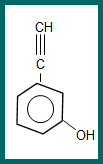Research Engineer for the development of a fermentation biotransformation process to produce a high performance polymer intermediate with applications in stealth technology for the US Air Force. Developed and piloted the manufacturing process and prepared an operating and capital cost model to guide research and development efforts.
| Unit operations: | Fermentation, Centrifugation, Plug flow reaction |
| Product: | m-Hydroxyphenylacetylene |
| Company: | US Air Force |
My first job out of graduate school was at Bio-Technical Resources (BTR) in Manitowoc, Wisconsin and this was my first process development project at BTR. This was during the period when the first benzene and toluene dioxygenases were being discovered and characterized and one of the BTR microbiologists had identified a microorganism that was able to metabolize phenylacetylene to the cis-dihydrodiol. He had also discovered how to simply dehydrate the cis-dihydrodiol to m-hydroxyphenylacetylene.
My role was to translate the shake flask work into fermentors. I developed a two-liquid-phase fermentation that used an aliphatic organic phase as a reservoir for the highly toxic phenylacetylene. I also developed an inexpensive inline sensor to measure the phenylacetylene concentration in the broth and a control strategy to feed phenylacetylene as needed to maintain the optimum concentration.

I also developed a simple continuous reactor process to convert the phenylacetylene cis-dihydrodiol in the cell-free broth to m-hydroxyphenylacetylene with a high yield.
This work was funded by the US Air Force as m-hydroxyphenylacetylene had (has?) potential value in polymers used for stealth coatings. m-Hydroxyphenylacetylene has a particularly strong, pungent odor. One of the more memorable incidents on the project was when we traveled to the Air Force laboratories in Dayton, Ohio for a project meeting. The project microbiologist had brought along a small vial of the m-hydroxyphenylacetylene we had made to show to the Air Force chemists. Without even opening the vial, the odor was so strong in the building that it raised an alarm. It turns out the Air Force is well prepared for incidents like this and within minutes, powerful exhaust fans on the building roof were changing out all of the air in the building.

The following PowerPoint presentation is one that I prepared years ago for a job interview (which must have worked – I got the job). It gives a few more details of the project for those who are interested.